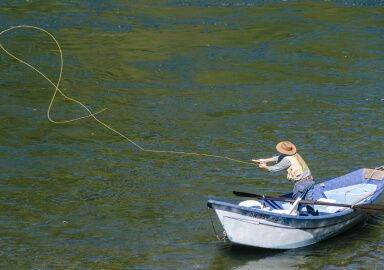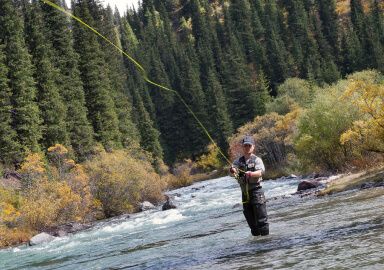Wolffish (Atlantic)
The Atlantic wolffish is a bottom living predator that feeds mostly on invertebrates and inhabits cold-water margins of the northern Atlantic Ocean.
View 1 listing
1
listings
–
price starting from
1
countries
–
to the nearest trip
About Wolffish (Atlantic)
Atlantic wolffish (Anarhinchas lupus) look like an overgrown, sabre-toothed blenny. They are an important commercial species and also of recreational importance, but numbers have declined recently in many areas. The Atlantic wolffish are elongate with a continuous, even dorsal fin stretching from the head to the caudal fin. The upper colour is variable, but always dark, usually grey, green, or blue with indistinct mottling. They have smallish eyes on the top of their heads and massive mouths armed with 4-6 large, strong, conical teeth at the front of both jaws.
The Atlantic wolffish can attain 1.5 m. (5 ft.) and 18 kg. (40 lbs.), mature at about 6 years of age and are long lived. They feed mostly on hard-shelled molluscs such as clams, cockles and whelks, but also take urchins, crabs, and fish. They are usually solitary, bottom dwelling fish that do not migrate or shoal. Unlike most fish, fertilization is internal and the eggs, at over 5 mm, are among the largest known fish eggs.
How to Catch?
Targeted shore angling for wolffish is not common as they are difficult to hook and even more difficult to land. Recreational fishing is, however, important in several of the northern areas where charter boats offer wolffish fishing along with species such as cod and halibut. The species is usually caught fairly close to shore and so medium to small boats on daily trips are most suitable. As they are a bottom fish often in deepish water, spinning rods using fixed spool or multiplier reels and braid line are best.
Medium to light tackle works well as the fish are not usually very large and mostly hooked above the bottom and thus away from cover. It is best to anchor or drift above an area where wolffish are known to be, drop a live bait or artificial jig and then gently, but firmly, lift the bait up and down. The most natural baits would be clams and other shellfish, but fillets of local fish also work well - as do plastic baits and metal jigs. Using a local boat, skipper and equipment can save a lot of time, effort and frustration and will usually result in success. Competent outfitters can be found in most of the northern harbours.
Daytime is the easiest, safest and most productive time to fish. Wolffish are one of the fish species that require careful handling, as their teeth can easily inflict a serious bite on an unwary angler. Holding them by the gills or body is the best approach for unhooking a wolffish.


